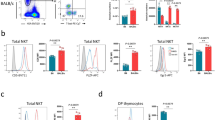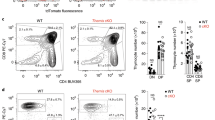Abstract
Cytokines are important in the regulation of haematopoiesis and immune responses, and can influence lymphocyte development. Here we have identified a class I cytokine receptor that is selectively expressed in lymphoid tissues and is capable of signal transduction. The full-length receptor was expressed in BaF3 cells, which created a functional assay for ligand detection and cloning. Conditioned media from activated human CD3+ T cells supported proliferation of the assay cell line. We constructed a complementary DNA expression library from activated human CD3+ T cells, and identified a cytokine with a four-helix-bundle structure using functional cloning. This cytokine is most closely related to IL2 and IL15, and has been designated IL21 with the receptor designated IL21R. In vitro assays suggest that IL21 has a role in the proliferation and maturation of natural killer (NK) cell populations from bone marrow, in the proliferation of mature B-cell populations co-stimulated with anti-CD40, and in the proliferation of T cells co-stimulated with anti-CD3.
This is a preview of subscription content, access via your institution
Access options
Subscribe to this journal
Receive 51 print issues and online access
$199.00 per year
only $3.90 per issue
Buy this article
- Purchase on Springer Link
- Instant access to full article PDF
Prices may be subject to local taxes which are calculated during checkout







Similar content being viewed by others
References
Wlodawer, A., Pavlovsky, A. & Gustchina, A. Hematopoietic cytokines: similarities and differences in the structures, with implications for receptor binding. Protein Sci. 2, 1373–1382 ( 1993).
Cosman, D. The hematopoietin receptor superfamily. Cytokine 5, 95–106 (1993).
Lok, S. et al. Cloning and expression of murine thrombopoietin cDNA and stimulation of platelet production in vivo. Nature 369, 565–568 (1994).
Palacios, R. & Steinmetz, M. IL3-dependent mouse clones that express B-220 surface antigen, contain Ig genes in germ-line configuration, and generate B lymphocytes in vivo. Cell 41, 727–734 (1985).
Bazan, J. F. Structural design and molecular evolution of a cytokine receptor superfamily. Proc. Natl Acad. Sci. USA 87, 6934– 6938 (1990).
Vigon, I. et al. Characterization of the murine Mpl proto-oncogene, a member of the hematopoietic cytokine receptor family: molecular cloning, chromosomal location and evidence for a function in cell growth. Oncogene 8, 2607–2615 (1993).
Skoda, R. C. et al. Murine c-mpl: a member of the hematopoietic growth factor receptor superfamily that transduces a proliferative signal. EMBO J. 12, 2645–2653 ( 1993).
Murakami, M. et al. Critical cytoplasmic region of the interleukin 6 signal transducer gp130 is conserved in the cytokine receptor family. Proc. Natl Acad. Sci. USA 88, 11349–11353 (1991).
Drachman, J. G. & Kaushansky, K. Dissecting the thrombopoietin receptor: Functional elements of the Mpl cytoplasmic domain. Proc. Natl Acad. Sci. USA 94, 2350– 2355 (1997).
Gurney, A. L., Wong, S. C., Henzel, W. J. & De Sauvage, F. J. Distinct regions of c-Mpl cytoplasmic domain are coupled to the JAK-STAT signal transduction pathway and Shc phosphorylation. Proc. Natl Acad. Sci. USA 92, 5292–5296 ( 1995).
von Heijne, G. A new method for predicting signal sequence cleavage sites. Nucleic Acids Res. 14, 4683–4690 (1986).
Hage, T., Sebald, W. & Reinemer, P. Crystal structure of the interleukin-4/receptor α chain complex reveals a mosaic binding interface. Cell 97, 271–281 (1999).
Zurawski, S. M. et al. Definition and spatial location of mouse interleukin-2 residues that interact with its heterotrimeric receptor. EMBO J. 12, 5113–5119 (1993).
Gong, J. H., Maki, G. & Klingemann, H. G. Characterization of a human cell line (NK-92) with phenotypical and functional characteristics of activated natural killer cells. Leukemia 8, 652–658 (1994).
Mrozek, E., Anderson, P. & Caligiuri, M. A. Role of interleukin-15 in the development of human CD56+ natural killer cells from CD34+ hematopoietic progenitor cells. Blood 87, 2632–2640 ( 1996).
Yu, H. et al. Flt3 ligand promotes the generation of a distinct CD34+ human natural killer cell progenitor that responds to interleukin-15. Blood 92, 3647–3657 (1998).
Kammer, W. et al. Homodimerization of interleukin-4 receptor α chain can induce intracellular signaling. J. Biol. Chem. 271, 23634–23637 (1996).
Sugamura, K. et al. The interleukin-2 receptor γ chain: Its role in the multiple cytokine receptor complexes and T cell development in XSCID. Annu. Rev. Immunol. 14, 179–205 (1996).
Grewal, I. S. & Flavell, R. A. CD40 and CD154 in cell-mediated immunity. Annu. Rev. Immunol. 16, 111– 135 (1998).
Foy, T. M., Aruffo, A., Bajorath, J., Buhlmann, J. E. & Noelle, R. J. Immune regulation by CD40 and its ligand gp39. Annu. Rev. Immunol. 14, 591–617 (1996).
Callard, R. E., Armitage, R. J., Fanslow, W. C. & Spriggs, M. K. CD40 ligand and its role in X-linked hyper-IgM syndrome. Immunol. Today 14, 559–564 ( 1993).
Robertson, M. J. & Ritz, J. Biology and clinical relevance of human natural killer cells. Blood 76, 2421–2438 (1990).
Whiteside, T. L., Vujanovic, N. L. & Herberman, R. B. Natural killer cells and tumor therapy. Curr. Top. Microbiol. Immunol. 230, 221– 244 (1998).
Biron, C. A., Nguyen, K. B., Pien, G. C., Cousens, L. P. & Salazar-Mather, T. P. Natural killer cells in antiviral defense: function and regulation by innate cytokines. Annu. Rev. Immunol. 17, 189–220 (1999).
Williams, N. S. et al. Natural killer cell differentiation: insights from knockout and transgenic mouse models and in vitro systems. Immunol. Rev. 165, 47–61 ( 1998).
Gubler, U. & Hoffman, B. J. A simple and very efficient method for generating cDNA libraries. Gene 25, 263–269 (1983).
Morris, A. et al. in Animal Cell Technology (ed. Carrondo, M. J. T.) 529–534 (Kluwer Academic, The Netherlands, 1997).
Stahl, N. et al. Choice of STATs and other substrates specified by modular tyrosine-based motifs in cytokine receptors. Science 267, 1349–1353 (1995).
Dzaki, K., Kikly, K., Michalovich, D., Young, P. R. & Leonard, W. J. Cloning of a type I cytokine receptor most related to the IL-2 receptor β chain. Proc. Natl Acad. Sci. USA 97, 11439–11444 (2000).
Acknowledgements
We thank J. Lehner, J. Rosser, S. McMillen, S. Matthews, J. Coleman, S. Sexson, A. Adan, W. Lint, K. Hodges, L. Smith, J. Rodriguez, C. Noriega, B. Dedinsky, K. Kontor, J. Gray, M. Rixon and R. Hoffman for technical assistance; and P. McKernan, J. Kelly, S. Jaspers, G. McKnight, G. Rosenberg, K. Swiderek, D. Prunkard, B. Persson, W. Kindsvogel and T. Bukowski for project advice. Nomenclature has been approved by HUGO.
Author information
Authors and Affiliations
Corresponding author
Rights and permissions
About this article
Cite this article
Parrish-Novak, J., Dillon, S., Nelson, A. et al. Interleukin 21 and its receptor are involved in NK cell expansion and regulation of lymphocyte function. Nature 408, 57–63 (2000). https://doi.org/10.1038/35040504
Received:
Accepted:
Issue Date:
DOI: https://doi.org/10.1038/35040504
This article is cited by
-
Co-expression of IL-21-Enhanced NKG2D CAR-NK cell therapy for lung cancer
BMC Cancer (2024)
-
NK cells as powerful therapeutic tool in cancer immunotherapy
Cellular Oncology (2024)
-
New insights into the stemness of adoptively transferred T cells by γc family cytokines
Cell Communication and Signaling (2023)
-
The identification and expression of an interleukin-21 receptor in large yellow croaker (Larimichthys crocea)
Molecular Biology Reports (2023)
-
Cytokine-enhanced cytolytic activity of exosomes from NK Cells
Cancer Gene Therapy (2022)
Comments
By submitting a comment you agree to abide by our Terms and Community Guidelines. If you find something abusive or that does not comply with our terms or guidelines please flag it as inappropriate.



